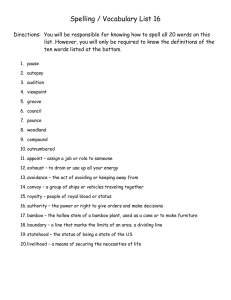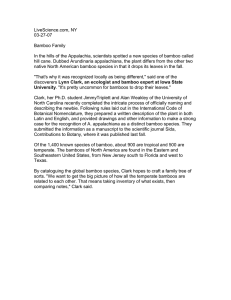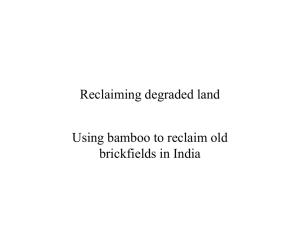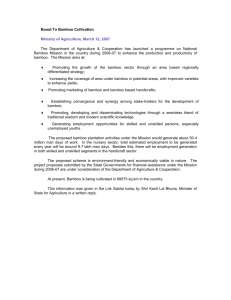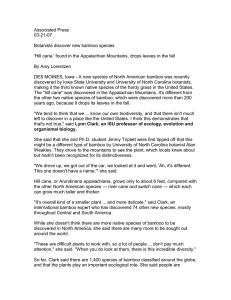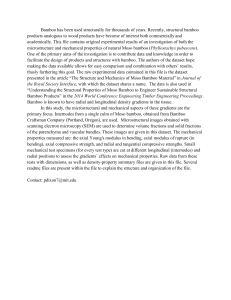Research Journal of Applied Sciences, Engineering and Technology 3(4): 245-251,... ISSN: 2040-7467 © Maxwell Scientific Organization, 2011
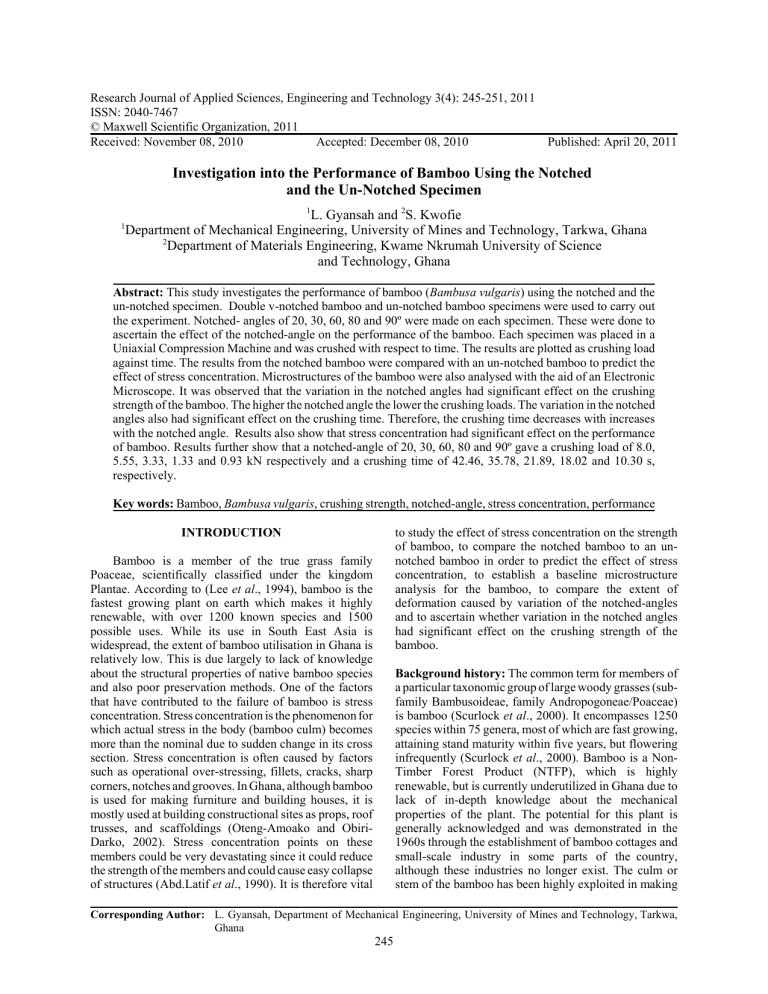
Research Journal of Applied Sciences, Engineering and Technology 3(4): 245-251, 2011
ISSN: 2040-7467
© Maxwell Scientific Organization, 2011
Received: November 08, 2010 Accepted: December 08, 2010 Published: April 20, 2011
Investigation into the Performance of Bamboo Using the Notched and the Un-Notched Specimen
1
L. Gyansah and
2
S. Kwofie
1
Department of Mechanical Engineering, University of Mines and Technology, Tarkwa, Ghana
2
Department of Materials Engineering, Kwame Nkrumah University of Science and Technology, Ghana
Abstract: This study investigates the performance of bamboo ( Bambusa vulgaris ) using the notched and the un-notched specimen. Double v-notched bamboo and un-notched bamboo specimens were used to carry out the experiment. Notched- angles of 20, 30, 60, 80 and 90º were made on each specimen. These were done to ascertain the effect of the notched-angle on the performance of the bamboo. Each specimen was placed in a
Uniaxial Compression Machine and was crushed with respect to time. The results are plotted as crushing load against time. The results from the notched bamboo were compared with an un-notched bamboo to predict the effect of stress concentration. Microstructures of the bamboo were also analysed with the aid of an Electronic
Microscope. It was observed that the variation in the notched angles had significant effect on the crushing strength of the bamboo. The higher the notched angle the lower the crushing loads. The variation in the notched angles also had significant effect on the crushing time. Therefore, the crushing time decreases with increases with the notched angle. Results also show that stress concentration had significant effect on the performance of bamboo. Results further show that a notched-angle of 20, 30, 60, 80 and 90º gave a crushing load of 8.0,
5.55, 3.33, 1.33 and 0.93 kN respectively and a crushing time of 42.46, 35.78, 21.89, 18.02 and 10.30 s, respectively.
Key words: Bamboo, Bambusa vulgaris , crushing strength, notched-angle, stress concentration, performance
INTRODUCTION
Bamboo is a member of the true grass family
Poaceae, scientifically classified under the kingdom
Plantae. According to (Lee et al ., 1994), bamboo is the fastest growing plant on earth which makes it highly renewable, with over 1200 known species and 1500 possible uses. While its use in South East Asia is widespread, the extent of bamboo utilisation in Ghana is relatively low. This is due largely to lack of knowledge about the structural properties of native bamboo species and also poor preservation methods. One of the factors that have contributed to the failure of bamboo is stress concentration. Stress concentration is the phenomenon for which actual stress in the body (bamboo culm) becomes more than the nominal due to sudden change in its cross section. Stress concentration is often caused by factors such as operational over-stressing, fillets, cracks, sharp corners, notches and grooves. In Ghana, although bamboo is used for making furniture and building houses, it is mostly used at building constructional sites as props, roof trusses, and scaffoldings (Oteng-Amoako and Obiri-
Darko, 2002). Stress concentration points on these members could be very devastating since it could reduce the strength of the members and could cause easy collapse of structures (Abd.Latif et al ., 1990). It is therefore vital to study the effect of stress concentration on the strength of bamboo, to compare the notched bamboo to an unnotched bamboo in order to predict the effect of stress concentration, to establish a baseline microstructure analysis for the bamboo, to compare the extent of deformation caused by variation of the notched-angles and to ascertain whether variation in the notched angles had significant effect on the crushing strength of the bamboo.
Background history: The common term for members of a particular taxonomic group of large woody grasses (subfamily Bambusoideae, family Andropogoneae/Poaceae) is bamboo (Scurlock et al ., 2000). It encompasses 1250 species within 75 genera, most of which are fast growing, attaining stand maturity within five years, but flowering infrequently (Scurlock et al ., 2000). Bamboo is a Non-
Timber Forest Product (NTFP), which is highly renewable, but is currently underutilized in Ghana due to lack of in-depth knowledge about the mechanical properties of the plant. The potential for this plant is generally acknowledged and was demonstrated in the
1960s through the establishment of bamboo cottages and small-scale industry in some parts of the country, although these industries no longer exist. The culm or stem of the bamboo has been highly exploited in making
Corresponding Author: L. Gyansah, Department of Mechanical Engineering, University of Mines and Technology, Tarkwa,
Ghana
245
Res. J. Appl. Sci. Eng. Technol., 3(4): 245-251, 2011 products like furniture, boats, toothpicks, food containers, mats, slide rules, musical instruments and weapons. It is quite common in the construction of housing, scaffolding and bridges, in Asia, but it is usually a temporal exterior structural material. Wang and Shen (1987) stated that there are about 60 to 70 genera and over 1200 to 1500 species of bamboo in the world. About half of these species grow in Asia, most of them within the Indo-
Burmese region, which is considered to be their area of origin. Most of the bamboos need a warm climate, abundant moisture, and productive soil, though some do grow well in reasonably cold weather, below -20ºC
(Wang and Shen, 1987). Lee et al . (1994) stated that the smaller bamboo species are mostly found in high elevations or temperate latitudes, and the larger ones are abundant in the tropic and sub-tropic areas. The adaptability of bamboo is quite high, because some bamboo species from one country have been introduced to other countries. The most popular and valuable bamboo species in Asia, Phyllostachys pubescences or the Moso bamboo has been grown successfully in South Carolina and some other south-eastern states in America for more than 50 years (Lee et al.
, 1997).
Bamboos are also adaptable to various types of habitat. They grow in plains, hilly and high-altitude mountainous regions, and in most kind of soils, except alkaline soils, desert, and marsh (Wang and Shen, 1987).
(Abd. Latif and Abd. Razak, 1991) mentioned that bamboo could grow from sea level to as high as 3000 meter. Bamboo grows very well on drained sandy to clay loom or from underlying rocks with pH of 5.0 to
6.5. Bamboo growth depends on species, but generally all bamboo matures quickly. Aminuddin and
Abd.Latif (1991) stated that bamboo might have 40 to 50 stems in one clump, which adds 10 to 20 culms yearly.
Bamboo can reach its maximum height in 4 to 6 months with a daily 15 to 18 cm (5 to 7 inches). Wong (1995) stated that culms take 2 to 6 years to mature, which depends on the species. It is suggested that with a good management of the bamboo resource, the cutting cycle is normally 3 years. According to (Lee et al ., 1994), bamboo matures in 3 to 5 years, which suggests that its growth is more rapid than any other plant on the planet. Some bamboo species have been observed to surge skyward as fast as 48 inches in one day.
According to the International Network for Bamboo and Rattan (INBAR), there are currently seven species of bamboo growing in Ghana viz. Bambusa arundinacea ,
Bambusa vulgaris , Bambusa pervariabilis , Bambusa vulgaris var . vitata , Bambusa bambos , Dendrocalamus strictus and Bambusa multiplex . Six of the seven species mentioned earlier were introduced from Asia with only
Bambusa vulgaris being the only indigenous Ghanaian species. The most common bamboo species in Ghana is
Fig. 1: Bambusa vulgaris species at UMaT campus
Fig. 2: Insect infested bamboo the Bambusa vulgaris , constituting some 95% of the total bamboo species in the country and found mostly in the forest zone (Ebanyenle et al ., 2005). The species was introduced about 70 years ago and has become naturalised and considered as native (Kigomo, 1997). The only native bamboo species in Ghana, to be found mostly in the savannah, is Oxytenanthera abyssinica. Figure 1 is a picture of Bambusa vulgaris sp. which was taken at the
University of Mines and Technology (UMaT) campus,
Ghana.
Bamboo can be destroyed by fungi and insects in a relatively short period of time. Therefore, it is necessary to protect and preserve the bamboo culms when good quality and durability are required. Fig. 2 is a picture of bamboo specimen attacked by insects. According to the
International Network for Bamboo and Rattan (INBAR), there are many methods of preserving bamboos but they can be divided into two general categories; non-pressure methods and pressurised methods. Non-pressure methods allow the preservative to penetrate the bamboo at a natural rate. Soaking the bamboo in preservative and allowing the
246
Res. J. Appl. Sci. Eng. Technol., 3(4): 245-251, 2011
V-Notch t do d
1
SEE V-NOTCH DETAIL
Stress point
θ
Notched-Angle
(b) V-NOTCH DETAIL
Fig. 3: Double V-Notched specimen t d
1 d o
Fig. 4: Un-notched specimen
force the preservative into the bamboo. These methods are more rapid but require pressurised vessels and facilities that are more expensive to establish and run.
With regards to the aforementioned histories and applications governing bamboo, failure still occur with its usage. It is therefore pertinent for one to understand the effect of stress concentration on the performance of bamboo. Stress concentration is the phenomenon for which actual stress in a member (bamboo culm) becomes more than the nominal due to sudden change in its cross section such as fillets, holes, cracks, notches, grooves and sharp corners. In this paper, a double-grooved is made on the periphery of one of the bamboo with notch angles of
20º, 30º 60º, 80º and 90º. This form a stress concentration points on the bamboo. Stress concentrated materials do not have the ability to withstand static loading over a long period of time under crushing test. The crushing strength is the maximum load the bamboo can carry before failure of the entire structure (Lakkad and Patel, 1981).
MATERIALS AND METHODS
Materials: The type of Bamboo specie used for this research is Bambusa vulgaris (Dried bamboos). Double v-notched bamboo and un-notched bamboo specimens were used to carry out the experiment. Notched- angles of
20, 30, 60, 80 and 90º were made on the double v-notched bamboo specimen. Each specimen was placed in a
Uniaxial Compression Machine and was crushed with respect to time. The experiments were carried out in the
Geological Engineering Laboratory at University of
Mines and Technology, Ghana in October, 2010. The bamboos used for this experiment were collected from the plantation around the University of Mines and
Technology’s football field.
Sample preparation: The dried Bambusa vulgaris as received from the forest fields were free from insect infestation. The specimens were polished to be free of nicks, dents and scratches. The specimens were dried in the sun for fourteen days between a temperature of 29 and
31ºC. The average moisture content was calculated to be
2%. The specimens were polished with abrasive paper.
Compressed air was blown on the surface of the specimen to remove dirt particles. Bamboo specimens were taken from the internodes of a single culm. The maximum specimen height for the experiment was 250 mm.
Specimen design: Double v-notched bamboo and unnotched bamboo specimens were used for the experiment.
“
2
” is the notched-angle. The dimensions for the specimens were chosen in accordance with the maximum height of the Uniaxial Compression Machine. The peak of the v-notch is termed the stress point. The stress point is the point where the stress concentration is very high.
Notched- angles of 20, 30, 60, 80 and 90º were made on the double v-notched specimen as shown in Fig. 3. The un-notched bamboo specimen is also illustrated in Fig. 4.
247
P
Res. J. Appl. Sci. Eng. Technol., 3(4): 245-251, 2011
Bamboo Specimen
Base Plate
P
Fig. 5: Double-notched bamboo specimen under compressive loading
External diameters “d o
” of the specimen are between 52 to 63 mm and thickness “t” between 6 to 12 mm. d
1
is the internal diameter.
Experimental: was conducted on the specimen.
Crushing test:
Crushing test and microstructural analysis
The crushing test was carried out using
Uni-axial Compression Machine. The specimen used was double-notched bamboo of varied angles and un-notched specimens. Three hundred and fifty specimens were used to carry out each of the crushing test. The specimens were cleaned and polished with abrasive paper of grades P
1200, P 120, P 80 and P 60, so as to avoid stress concentration points caused by any scratch or dent on the specimens’ surface. The maximum height of the specimens was 250 mm. Each specimen was placed inside the uni-axial compressive machine. The machine’s frame was properly closed and the controlling unit was triggered to start compression and the specimen is tested to failure.
The machine automatically cut off when the specimen was crushed and the load of failure and the crushing time is displayed on the monitor. The monitor displays a graph of load of failure (crushing strength) against time of failure. Figure 5 shows a double-notched bamboo specimen under crushing test.
Microstructure analysis: Microstructure of the specimens was performed before the specimen was tested and after the specimen was tested. Before the crushing test, two pieces both the notched and un-notched specimen of dimension 20 mm × 20 mm were cut out.
Highly compressed air was blown over the specimens to get rid of all dirt on the surface. The polishing of the specimens was done with the abrasive paper to get a clear view of the microstructure. The abrasive papers were graded according to their roughness from 60 to 1200.
From grade 60 to grade 400, the polishing of specimen were done by hand and from grade 800 to grade 1200 the polishing was done with a polishing machine. The specimens were firmly secured on a plasticizer by a press machine. Electronic microscope was used to take the microstructure. Magnification of 10x was used in this experiment. After the specimens were tested in a uniaxial compression machine, two pieces of both the notched and un-notched specimens of dimension 20 mm × 20 mm were also cut out using the hacksaw. The specimen’s surface was blown with compressed air to get rid of all dirt. The surface to be investigated was grinded with abrasive paper. The specimen was firmly secured on a plasticizer and electronic microscope was used to expose the microstructure of the specimen.
RESULTS AND DISCUSSION
Experimental results on the performance of the crushing strength for a double-notched and un-notched specimen are shown in Table 1. From Table 1, it is obvious that the crushing stress for the double-notched specimen decreases as the notched-angle increases.
Instantaneously, the average time of failure also decreases with increase in the notched-angle. This signifies the fact that as the notched-angle is being widened highest stresses are concentrated at the peak of the notched-angle that propagates the failure of the entire bamboo specimen under compressive loading. The maximum load that caused failure of the double-notched bamboo specimen is less than the un-notched specimen. The maximum crushing load for double-notched bamboo specimen for notched-angle of 20, 30, 60, 80 and 90º for a specimen height of 250 mm are 8.00, 5.33, 3.33, 1.33 and 0.93 kN, respectively whiles an un-notched bamboo specimen had
248
Table 1: Result from the uniaxial compression machine for double-notched and un-notched specimen
No.
1
2
3
4
5
6
Notched angle (
2
)
20º
30º
60º
80º
90º
Un-notched
Average radius (mm)
31.83
32.37
32.08
32.10
32.15
32.20
Average area (m 2 )
6.62x 10
G 4
6.00x10
G 4
4.85x10
G 4
3.44x10
G 4
4.65x 10 G 4
1.55x10
G 3
Average maximum load (kN)
8.00
5.33
3.33
1.33
0.93
62.67
Average crushing stress (MN/m 2 )
12.08
8.88
6.73
3.83
2.67
40.35
10
8
6
4
Load =8.00kN, Time =42.46sec.
2
0
0 20
Time (s)
40 60
Fig. 6: Load-time graph for 20 o
double-notched specimen
4
3
6
5
2
Load =5.33kN, Time =35.78sec.
1
0
0 10 20
Time (s)
30 40
Fig. 7: Load-time graph for 30 o double-notched specimen
4
Load =3.33kN, Time =21.89sec.
3
2
1
Res. J. Appl. Sci. Eng. Technol., 3(4): 245-251, 2011
Average time (s)
42.46
35.78
21.89
18.02
10.30
46.38
1.4
1.2
1
0.8
0.6
0.4
0.2
0
0
Load =1.33kN, Time =18.02sec.
5 10
Time (s)
15
Fig. 9: Load-time graph for 80 o double-notched specimen
20
Load =0.93kN, Time =10.30sec.
1
0.8
0.6
0.4
0.2
0
0 5 10
Time (s)
15
Fig. 10: Load-time graph for 90 o double-notched specimen
70
60
50
40
30
20
10
0
0
Load =62.67kN, Time =46.38sec.
20
Time (s)
40 60
0
0 10
Time (s)
20
Fig. 8: Load-time graph for 60 o double-notch specimen
30 maximum crushing load of 62.67 kN. This presupposes that the double-notch made at the periphery of the specimen served as a point where crack started when the specimens were under compressive loading. The double-
Fig. 11: Load-time graph for un-notched specimen notch reduced the strength of the bamboo and shortened its time of failure. Figure 6-12 shows a graph of load (kN) against time of failure (s). The graphs explain the relation between the crushing loads, notched-angles and the time of failure. The graphs in effect explain the effect of increasing notch angle on the performance of the
Bamboo. From Fig. 6-11, it could be seen that as the
249
Res. J. Appl. Sci. Eng. Technol., 3(4): 245-251, 2011
30
20
10
0
0
70
60
50
40
Un-Notched Speciamen
10 20
Time (s)
30 40 50
Fig. 12: Load-time graph for notched and un-notched specimen notched- angle increases the crushing load decreases till a maximum load of failure occurs. Example, the maximum load of failure for a 20º double-notched bamboo specimen is 8.00 kN. The maximum load is that force that caused total failure of the bamboo. It is further deduced from the graphs that the notched-angle increases with decreases in the crushing time. Figure 12 shows a graph of a double-notched and un-notched bamboo specimen. From Fig. 12, it could be seen that the unnotched bamboo specimen had maximum crushing load of 62.67 kN and crushing time of 46.38 s while the 20º double-notched had a maximum crushing load of 8.00 kN and crushing time of 42.46 s. From Fig. 12, it can be concluded that the time of failure of un-notched is higher than the double-notched bamboo specimen. Furthermore, the maximum load of failure for un-notched is also higher than the double-notched bamboo specimen. Maximum stress range of 28.27 MN/m 2 is significant enough to conclude that notch has effect on the performance of the bamboo. It is therefore obvious from the findings that a cut from a cutlass on a bamboo culm can reduce its strength drastically.
The microstructure of the bamboo specimen before crushing is shown in Fig. 13. The microstructure analysis is to show the deformation characteristics of the bamboo.
From the diagram it can be seen that the bamboo fibres are aligned longitudinally to each other and are very compact. The compact nature of the cellulose fibres explains why bamboo resists very high compressive load.
The whitish parts explain the low level of moisture content.
The microstructure of the bamboo specimen after crushing shows significant change in microstructure with respect to the different notched-angles and un-notched bamboo specimen. These are seen in Fig. 14 to 16. From
Fig.14 and 16, it could be seen that as the notched-angle increased deformation of the bamboo fibres are severe, showing contour-like pattern which actually represent the highly stressed points in the microstructure. It can be concluded that the different notched-angles have significant effect on the deformation characteristics of the bamboo fibres.
Fig. 13: Microstructure of bamboo specimen before crushing
Fig. 14: Double-notched bamboo specimen at 20 o
notched-angle
Fig. 15: Double-notched bamboo specimen at 90 o
notched-angle
Fig. 16: Microstructure of un-notched specimen after crushing
Comparing the microstructure of the double v-notched to that of the un-notched specimen, it can be observed in
Fig. 15 and 16 that there are significant contour-like deformations in their microstructures. The un-notched specimen showed deformations in its cellulose fibres but
250
Res. J. Appl. Sci. Eng. Technol., 3(4): 245-251, 2011 the deformation was not as severe as the 90 o doublenotched specimens. The severity of the deformation of the microstructure of the notched specimen is caused by the notch that was made at the periphery of the specimen since both specimens were subjected to the same uni-axial compressive loadings. Deformation mimics that of a twisted bundle of sticks.
CONCLUSION
Technology, Ghana and Mrs. Araba Gyansah,
“Mathematician and Statistician”, for their valuable comments and suggestions. Authors are also thankful to the management of the Geological Engineering
Laboratory for making the laboratory available for this research.
REFERENCES
Based on the results obtained the following conclusions can be drawn:
C Variation in the notched angles had significant effect on the crushing strength of the bamboo. The higher the notched angle the lower the crushing loads.
C The variation in the notched-angles also had significant effect on the crushing time. Therefore, the crushing time decreases with increases with the notched angle.
C This study shows that stress concentration had significant effect on the performance of bamboo.
Notched bamboo specimen fails earlier than unnotched specimen.
C
Notched-angles of 20, 30, 60, 80 and 90º gave a crushing load of 8.0, 5.55, 3.33, 1.33 and 0.93 kN, respectively and a crushing time of 42.46, 35.78,
21.89, 18.02, and 10.30 s, respectively.
C The un-notched bamboo specimen at a height of 250 mm had a maximum crushing load of 62.67 kN and crushing time of 46.38 s.
C As the notched-angle increased deformation of the bamboo fibres are severe, showing contour-like pattern which actually represent the highly stressed points in the microstructure. Therefore, different notched-angles have significant effect on the deformation characteristics of the bamboo fibres.
RECOMMENDATION
Based on the results obtained from the experiment the following recommendations can be made;
C
Further studies should be conducted into other mechanical properties of bamboo.The results should be compared with that of other Timber Forest
Product (TFP) like Odum, Wawa, and Sapele.
C Ghanaians should be mindful of the effect of stress concentration on materials since a cut from a cutlass on a bamboo culm can reduce its strength drastically which with time will propagate and cause total failure of the entire material.
ACKNOWLEDGMENT
The authors are thankful to Prof. Adetunde, I.A, the
Dean of Faculty of Engineering, University of Mines and
Abd. Latif, M. and O. Abd. Razak, 1991. Availability, distribution of bamboo and its industrial status in
Peninsular Malaysia.
Proceedings of the 4th
International Bamboo Workshop on Bamboo in Asia and the pacific. Chiangmai, Thailand, pp: 60-67.
Abd. Latif, M., W.A. Wan Tarmeze and A. Fauzidah,
1990. Anatomical features and mechanical properties of three Malaysian bamboos. J. Trop. Forest Sci.,
2(3): 227-234.
Aminuddin, M. and M. Abd. Latif, 1991. Bamboo in
Malaysia: Past, present and future research.
Proceedings of the 4th International Bamboo
Workshop on Bamboo in Asia and the pacific,
Chiangmai, Thailand, pp: 349-354.
Ebanyenle, E., K. Ameyaw and E.J. Oware, 2005.
Ghana’s Bamboo Industry: Country Report, Training course, September 25-25 November, Hangzhou,
China, pp: 1-7.
Kigomo, B.N., 1997. A State-of-the-Art on Bamboo and
Rattan Research and Development in Africa. KEFRI,
INBAR, New Delhi-India, pp: 51.
Lakkad, S.C. and J.M. Patel, 1981. Mechanical properties of Bamboo. Nat. Compos., 14(4): 319-322.
Lee, A.W.C., B. Xuesong and P.B. Audiman, 1997.
Flexural properties of bamboo reinforced southern pine OSB beams. Forest Prod. J., 47(6): 74-78.
Lee, A.W.C., B. Xuesong and N.P. Perry, 1994. Selected physical and mechanical properties of giant timber bamboo grown in South Carolina. Forest Prod. J.,
44(9): 40-46.
Oteng-Amoako, A.A. and B. Obiri-Darko, 2002. Rattan as a sustainable industry in Africa: The need for technological interventions. In Rattan: Current research issues and prospects for conservation and sustainable development. Non Wood Forest Prod.,
14: 89-100.
Scurlock, J.M.O., D.C Dayton and B. Hames, 2000.
Bamboo: An overlooked biomass resource? Biomass
Bioenerg., Published by Elsevier Science Ltd., 19(4):
229-244.
Wang, D. and S.J. Shen, 1987. Bamboos of China,
Timber Press, Portland, Oregon.
Wong, K.M., 1995.
The bamboos of Peninsular Malaysia,
Forest Research Institute Malaysia (FRIM) in collaboration with Forest Research Centre. Forestry
Department, Sabah, Malaysia. Malayan Forest
Records, No. 41.
251
